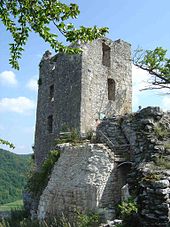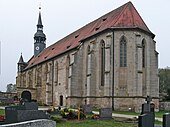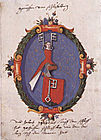Konrad II von Schlüsselberg


Konrad II von Schlüsselberg (* around 1277; † 14 September 1347 at Neideck Castle ) was the most influential and at the same time the last representative of the noble Franconian dynasty of the von Schlüsselbergs as a royal precursor and imperial ensign . From 1322 to 1336 he was the owner of the Reichssturmfahnlehen and therefore called himself "Konrad von Schlüsselberg zu Grüningen ".
Origin and family
Konrad II von Schlüsselberg came from the noble family of the von Schlüsselberg family , who were wealthy in Franconian Switzerland . His father was probably Konrad I von Schlüsselberg, one of the founders of the Schlüsselau Monastery. Konrad II was first mentioned in a document from 1296 as "the young gentleman". Among other things, he was lord of the castle, which gave it its name, to Schlüsselberg near Waischenfeld , but later preferred the expanded Neideck Castle.
According to the family list of the Hohenzollern family , his first marriage was with Lukardis († 1326), daughter of the burgrave Konrad of Nuremberg , and probably had three daughters with her: Agnes, Anna and Beatrix. Agnes is said to have married Heinrich von Plauen and after his death Hermann von Beichlingen . Anna von Schlüsselberg was abbess of the Schluesselau monastery from 1339 to 1379 .
Konrad von Schlüsselberg had a second marriage with the widowed Agnes von Württemberg-Helfenstein (approx. 1305-1373), a granddaughter of the bellicose Count Eberhard I of Württemberg . Both children from their first marriage were “paired up”: Beatrice von Schlüsselberg and Count Ulrich V. von Helfenstein-Blaubeuren († 1361). Konrad's second wife did not give birth to a male heir either. Their daughter Hildegard is said to have married Count Eitel Friedrich von Zollern . Another daughter of Konrad, Sophia von Schlüsselberg († after 1360), is said to have been married to Friedrich III, the old knight , von Hohenzollern-Schalksburg .
Forerunner of Ludwig of Bavaria


Konrad is considered a close confidante of King Ludwig the Bavarian , who was later crowned emperor, and distinguished himself as his forerunner and standard bearer in the Battle of Gammelsdorf (1313) and in the Battle of Mühldorf (1322): Konrad is supposed to counter this battle with his Franconian knights the Habsburg counter-king Friedrich the Fair decided early on for Ludwig.
On October 3, 1322, King Ludwig, the Bavarian, transferred the Sturmfahnlehen with the Reichsburg Grüningen and the city of Grüningen with all rights and fiefs, patronage and jurisdiction to him and his heirs in view of his services for the king and empire and as standard bearer in his victorious battle near Mühldorf , Villages, pastures, forests, bodies of water and watercourses, people and vassals, income and accessories to right and perpetual fiefs and orders all people and vassals belonging to the city and castle to hand over the rights mentioned to Conrad and his heirs in full and to be obedient to them to be.
Count Konrad von Vaihingen resided in neighboring Vaihingen an der Enz , who tried in vain on November 11, 1323 before the court court to enforce the claims of his wife Elisabeth, daughter of Gottfried von Schlüsselberg , against Bishop Johann von Bamberg , who took over the office instead of the intended one Ulrichs von Schlüsselberg had occupied. According to Römer , Elisabeth was a cousin of Konrad von Schlüsselberg, so Gottfried was not his father and Ulrich was probably his cousin. Conrad is said to have been to Vaihingen in Swabia for the first time in 1312.
In the course of the conflict with the Avignon resident Pope John XXII. said this on July 11, 1324 ban and interdict against King Ludwig and his close confidante, who also included Konrad von Schlüsselberg. From 1327 to 1329, Konrad accompanied King Ludwig to Rome, where he was crowned emperor for the first time in 1328 without papal participation and Konrad confirmed the enfeoffment with Grüningen. This is where Konrad stayed after returning from Italy and called himself "Konrad von Schlüsselberg zu Grüningen ". Whether he also had the " Schlüsselburg " built on the Schlüsselberg outside the city, which is provided with an imperial castle, its name seems to suggest, but cannot be proven.
Although Konrad had achieved an exposed position as a Grüninger fief in the Lower Swabian region, which was previously dominated by the Habsburgs, Count Ulrich III , who was initially on the side of the Habsburgs, was able to succeed . von Württemberg eventually gain greater political weight. As his governor, Ulrich III. In 1336, Emperor Ludwig encouraged Konrad von Schlüsselberg to cede the prestigious Grüninger Reichslehen with the Reichssturmfahne to the uncle of his second wife in return for compensation of 6000 pounds Haller .
Expansion of territorial rule in Franconia


Konrad then concentrated entirely on his Franconian headquarters and after Waischenfeld and Ebermannstadt , to which King Ludwig had granted market and town rights as early as 1315 and 1323, respectively , now also a village near Thüngfeld Castle to the town of Schlüsselfeld , which on June 10, 1336 received city rights. According to Voit, Konrad's extensive territory comprised seven high court districts: Schnaid, Senftenberg , Neideck, Waischenfeld, Thurndorf and Eschenbach. In addition to his three cities and 17 castles, he held shares and rights to seven other castles, the Klostervogtei of Schlüsselau and possessions in 72 places. 25 noble families served the Schlüsselberger; Schlüsselberg fiefs were given to 39 families.
Its increasing territorial weight displeased its powerful neighbors: the Bamberg prince-bishop , the prince-bishop of Würzburg and the burgrave of Nuremberg . In 1344, Emperor Ludwig was able to defuse the escalating conflict of interest between the Würzburg bishop Otto II von Wolfskeel and his allies with the Schlüsselberger, behind which the cities of Würzburg , Nuremberg , Rothenburg ob der Tauber and Windsheim stood. After the brothers Albrecht and Friedrich von Hohenlohe, as bishops of Würzburg and Bamberg, broke away from the emperor in 1346 and supported the election of the Luxembourg rival king Karl von Moravia , Konrad, loyal to the emperor, found himself embroiled in a deadly feud in 1347 .
Destruction of the Schluesselberger rule
The reason for the feud was, among other things, the dispute over sovereign customs and escort rights, and the excommunication of the outlawed Konrad as a justification : After the construction of a Schlüsselberg toll station near Streitberg , the Nuremberg burgrave Johann II fell in 1347 with the support of the two brothers Albrecht and Friedrich von Hohenlohe entered Konrad's territory as bishops of Würzburg and Bamberg. Hoping in vain for relief troops from Ludwig the Bavarian († 1347), Konrad was struck down on September 14, 1347 during the siege of his Neideck castle by a blinder hit . The winners largely divided up the Franconian territory of the Schlüsselbergers, who now had no male heirs, among themselves. Konrad's daughters received relatively little financial compensation.
Since Konrad was banned from church , he could not be buried in the Schlüsselberg grave in the Schlüsselau monastery. Presumably he was secretly buried on the outer wall of the monastery church, on which an incised inscription refers to Konrad (see picture).
A considerable part of the Schlüsselberg estates and fiefdoms passed into the joint ownership of the Würzburg and Bamberg bishoprics , including after the division of May 12, 1349 the castles (Nieder-) Senftenberg, Thüngfeld, Ebermannstadt, Schlüsselfeld, Neideck, Waischenfeld , Streitberg and Greifenstein . Previously Schlüsselberger property, including shares in Castle Niedersenftenberg, Eggolsheim and Ebermannstadt , were finally sold to the bishopric of Bamberg in 1384 by the Würzburg bishop Gerhard von Schwarzburg .
In addition to the Franconian monastery in Schlüsselau , three Swabian monasteries apparently benefited from the allodial inheritance of Konrad and his daughters or cousins, as indicated by the use of the Schlüsselberg coat of arms:
Ancestral coat of arms in the Hechingen monastery church St. Luzen
Donor's coat of arms in the monastery chronicle of the Gutenzell Imperial Abbey
Coat of arms of the Marchtal monastery and the municipality of Obermarchtal
In the course of his life , Konrad , who was striving for the salvation of his soul , had several foundations at eleven different institutions: In addition to the Schlüsselau Monastery, "nostrum ac nostrorum progenitorum plantata", his and his ancestors' foundation, he also paid tribute to the Heilsbronn, Langheim, Speinshart, Ebrach convents , Michelsberg, Bronnbach and the St. Gangolf, St. Stephan and St. Theodor monasteries in Bamberg and finally the Katharinenspital in Forchheim .
literature
- Rudolf Endres: Konrad von Schlüsselberg. In: Gerhard Pfeiffer (Ed.): Fränkische Lebensbilder. Volume 4. Kommissionsverlag Ferdinand Schöningh, Würzburg 1971, ( Publications of the Society for Franconian History, Series VII A. Volume 4), pp. 27-48.
- Paul Österreicher: New contributions to the history of the former rule of the Schlüsselberg . Bamberg 1823.
- Hermann Römer : Markgröningen in the context of regional history I., prehistory and the Middle Ages . Markgröningen 1933, pp. 111-121.
- Heinz Thomas: Ludwig the Bavarian (1282-1347). Kaiser and Heretic , Regensburg 1993.
- Gustav Voit: The Schlüsselberger. History of a Frankish noble family . Nuremberg 1988.
References and comments
- ↑ The title of count assigned by Siebmacher and Wolleber (1591) is not documented and could at most come from Konrad II, who was enfeoffed with the Grüningen burgrave in 1322 . Image source: David Wolleber : Chorographia Württemberg, [Schorndorf] 1591, University Library Tübingen, Mh 6.1
- ^ Painting (19th century) in the town hall of Mühldorf by Emperor Ludwig with imperial crown , imperial orb and holy lance
- ^ A b Hermann Römer , Markgröningen in the context of Landesgeschichte I., Prehistory and the Middle Ages , Markgröningen 1933, p. 112 f.
- ↑ Master list of the House of Württemberg under Eberhard I.
- ↑ See Battle of Gammelsdorf
- ^ [RI VII] H. 1 n. 28 Regesta Imperii
- ↑ Landgrave Regests online No. 11869. Regest of the Landgraves of Hesse. In: Landesgeschichtliches Informationssystem Hessen (LAGIS).
- ^ Hermann Römer, Markgröningen in the context of Landesgeschichte I., Urgeschichte und Mittelalter , Markgröningen 1933, p. 113 (Stälin III, p. 160).
- ^ [RI VII] H. 1 n. 264 Regesta Imperii
- ^ Gustav Voit The Schlüsselberger. History of a Franconian noble family , Nuremberg 1988.
- ↑ Since 1337, Archbishop of Mainz Heinrich III was one of the allies of Würzburg bishop Otto II von Wolfskeel . von Virneburg and the Nuremberg burgrave Johann II. , since 1341 also Count Heinrich VIII. von Henneberg-Schleusingen .
- ^ Alfred Wendehorst : The Diocese of Würzburg Part 2 - The series of bishops from 1254 to 1455 . In: Max Planck Institute for History (Ed.): Germania Sacra - New Part 4 - The Dioceses of the Ecclesiastical Province of Mainz . Berlin 1969. ISBN 9783110012910 . Pp. 65-66.
- ↑ Heinz Thomas: Ludwig the Bavarian (1282-1347). Kaiser and Heretic , Regensburg 1993.
- ^ Alfred Wendehorst: The Diocese of Würzburg Part 2 - The series of bishops from 1254 to 1455 . In: Max Planck Institute for History (Ed.): Germania Sacra - New Part 4 - The Dioceses of the Ecclesiastical Province of Mainz . Berlin 1969. ISBN 9783110012910 . P. 85.
- ^ Alfred Wendehorst: The Diocese of Würzburg Part 2 - The series of bishops from 1254 to 1455 . In: Max Planck Institute for History (Ed.): Germania Sacra - New Part 4 - The Dioceses of the Ecclesiastical Province of Mainz . Berlin 1969. ISBN 9783110012910 . P. 112.
- ↑ The keystones in the nave show the ancestors of the builder Eitel Friedrich IV von Hohenzollern . According to Hermann Römer, one of his forefathers had married Markgröningen in the context of Landesgeschichte I., Urgeschichte und Mittelalter , Markgröningen 1933, p. 113, to Hildegard von Schlüsselberg, daughter of Konrad II and Anna von Württemberg.
- ↑ Cf. Gustav Voit at Neideck Castle (Schmittroth)
Web links
| personal data | |
|---|---|
| SURNAME | Konrad II von Schlüsselberg |
| ALTERNATIVE NAMES | Conradus de Sluzzelberch |
| BRIEF DESCRIPTION | Franconian nobleman, champion and bearer of the imperial storm flag |
| DATE OF BIRTH | around 1277 |
| DATE OF DEATH | September 14, 1347 |
| Place of death | Neideck Castle |



